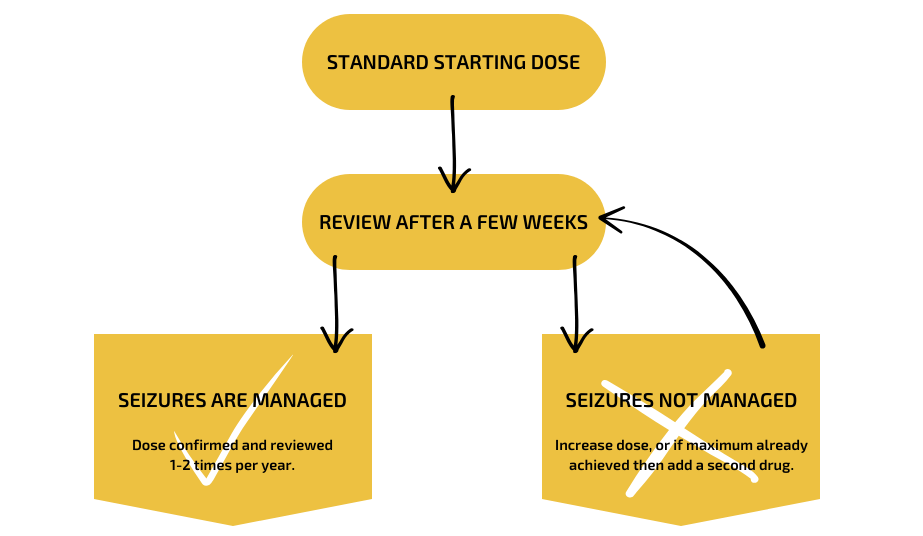TREATMENT FOR EPILEPTIC DOGS
When to start treatment
Specialists recommend starting epilepsy medications for pet’s that experience 2 or more seizures in a 6 month period, severe seizures or severe post-ictal signs, cluster seizures (two or more in 24 hours) or status epilepticus (prolonged seizure of more than 5 minutes or a series of seizures in quick succession without the animal regaining consciousness).
Studies on human epilepsy indicate that the higher the number and frequency of seizures before treatment is started, the harder the epilepsy may be to control. But each case of epilepsy is unique and practitioners will assess the risks and benefits of starting early treatment – as well as your expectations.
Treatment Goals
Epilepsy is a chronic condition with no cure. Whilst freedom from seizures would be an optimal goal, this is rarely achievable, and therefore the main goals of therapy are to:
- Reduce the number, intensity and duration of the seizures.
- Shorten the recovery time needed after each seizure.
When initiating treatment, the vet will discuss the goals with you and the goals will differ for each pet and owner.
In order to then achieve this goal and successfully manage the seizures, it is essential that you closely follow all instructions for giving prescribed medications.
Treatment plan and monitoring
Treatment for idiopathic epilepsy is usually life-long. The amount and type of epilepsy medication can vary between dogs, therefore two dogs of a very similar size can require very different doses of medication. For this reason, medications for epilepsy need to be closely tailored to your pet which is why it is important to have regular check-ups with your vet.
Anti-epileptic medications
The medications used to treat epilepsy work by dampening down the abnormal excitatory signals in the brain that cause the seizure. They can sometimes dampen down other brain signalling too, which may mean your pet is a little more sleepy, a bit wobbly or off-balance for the first few weeks after starting their epilepsy medication. Most pets will get used to the medication and these effects will resolve without any intervention within a couple of weeks. Some pets may want to eat, drink and urinate more. If you have any concerns regarding side effects in your pet then please discuss these with your vet.
Initiating treatment
When initiating an anti-epileptic drug, a standard starting dose will be given, but it’s difficult to predict how your dog will respond to the treatment. Therefore, they will typically require a check-up and blood test with the vet after a couple of weeks. This may result in an adjustment of their dose and another check-up after that. This cycle may need to be repeated a few times until the dose is optimal for your pet.
Treatment monitoring and adjustments
Once the seizures are under control and the treatment is well tolerated, the frequency of these check-ups can be reduced. Typically, there will be a check-up and blood test 3 months after finding the optimal dose, and, if seizure control remains stable, then ongoing vet check-ups will usually be every 6-12 months.
It is important that you do not make any changes (reduce the dose or change the medication) without medical advice from your vet as it could worsen seizures or result in side effects.
Keeping a seizure diary is a helpful way to monitor your pet’s response to therapy. You can download one here.
Treatment plan for epilepsy

Do not forget to give the treatment
The seizures can only be managed if the amount of anti-epileptic drug in the bloodstream remains stable. Forgetting to give the treatment to your pet will lead to a fall in blood levels, and risk a return of the seizures. In the event of missing a dose, contact your vet for advice.
Do not exceed/change the prescribed dose
Sticking to the dose prescribed by your vet will make it easier to manage the seizures and minimise side effects.
Never stop treatment without first talking to your vet
Only a vet should decide whether to stop treating an epileptic dog. Stopping or reducing an anti-epileptic medication is a common cause of cluster seizures or status epilepticus, which are life threatening and require emergency treatment.
Can the treatment ever be stopped?
For the vast majority of dogs with epilepsy, treatment is lifelong and should not be stopped.
Dogs that have only experienced a few seizures, have been treated early and have been seizure free for at least 2 years, may be considered in remission. In these patients there is some debate amongst specialists as to whether treatment can be slowly reduced and stopped (following various testing and discussion with your vet). If there are no unmanageable side effects, many vets will continue with treatment, as discontinuing poses a risk for relapse and return of seizures.
Any change in treatment, including discontinuation must be done under the direction and supervision of your vet.
Homeopathy, osteopathy, acupuncture: alternative therapies for epileptic pets
What are alternative therapies? Unlike conventional medicine, these are non-conventional and complementary therapies, including homeopathy, phytotherapy, aromatherapy, osteopathy, acupuncture and Chinese traditional medicine.
There are currently very few studies of the effects in dogs and cats, and they are not regulated strictly like medicines are. This means that both the efficacy and safety of these methods have not been established at this current time, therefore they cannot be recommended as treatment for epilepsy. If you hear or read of interesting alternative therapies, these should be discussed with your vet.